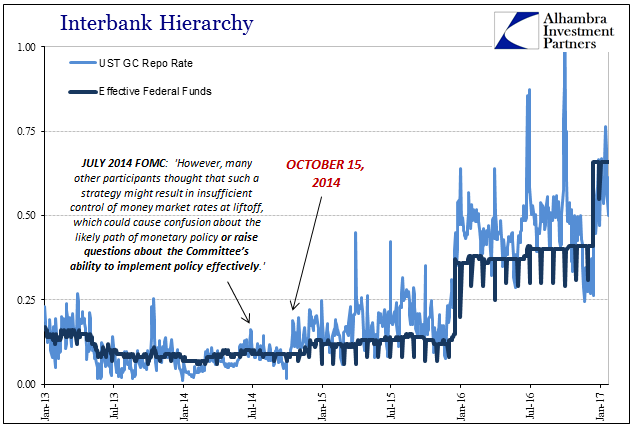On February 23, the equivalent yield for the us4w was just 39 bps. That was almost 11 bps (counting full pips) below the so-called money rate floor, to which T-bills are a near enough equivalent to count in that view. It was also 36 bps below IOER, which at one time was thought to be a huge consideration for any such floor. As a paper prepared by and for the Federal Reserve Board (FRB) explained in February 2015:
Excess reserves are effectively free of default and liquidity risk, so the IOER rate should be a lower bound for a bank’s opportunity cost of alternative investments, such as loans or purchases of securities. Accordingly, if banks were the only investors (lenders) in money markets, IOER would set a floor for money market rates, as no bank would want to lend at a lower short-term interest rate.
In fact, this has never been true. IOER was introduced in late 2008 as an emergency measure to do just what the quoted passage identifies; to promote a lower boundary for federal funds and other money market rates because despite the conditions of that period the federal funds rate was considerably less than the target rate. It would remain there until ZIRP, as the effective federal funds rate actually declined further even after a realignment of IOER to equal the policy target (a higher IOER was supposed to pull effective federal funds that much closer).

This was no small thing, though to this day it goes almost completely unappreciated. The panic period, through both subsequent liquidations (the one after Lehman as well as the one in early 2009), featured counterintuitively too much cash in the US (NYC). Financial participants preferred to hoard it in the federal funds market than to place it with the Federal Reserve. This had nothing to do with credit risk, and everything to do with what is wrong still today – liquidity preferences.

Recognizing the error years later, the FOMC decided that the IOER would become the “ceiling” (it hasn’t worked there, either) for money markets to where the Reverse Repo Program (RRP) would replace it as the “floor.” Again the FRB paper:
In theory, as with the IOER rate, the ON RRP rate set by the FOMC would be expected to establish a floor on short-term interest rates, particularly if ON RRPs are available in sufficient quantity to satisfy demand at the ON RRP rate. Thus, the Desk’s July 2013 presentation on the use of ON RRPs focused on a “fixed-rate, full-allotment” facility—that is, one that would offer ON RRPs without limit at the fixed rate set by the FOMC. With such a facility in place, ON RRPs would always be available to counterparties as an alternative to other investments, so counterparties that can invest in ON RRPs generally should be unwilling to lend elsewhere at lower rates.
As we have seen, however, in both GC repo as well as T-bill rates, this hasn’t been the case, either. Hierarchy is missing because banks are missing, and in a credit-based currency regime that means everything. And as stated so many times before, their absence is not a product of retroactive attempts at regulating out another 2008 (such as Dodd-Frank and Basel 3). Errors and irregularity long predates those efforts.

